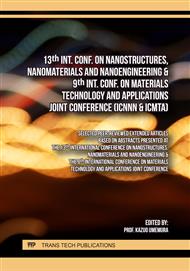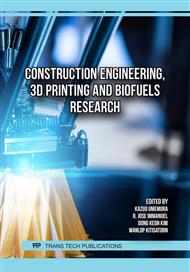[1]
X. Geng et al., "Biomimetically ordered ultralong hydroxyapatite nanowires-based hierarchical hydrogel scaffold with osteoimmunomodulatory and osteogenesis abilities for augmenting bone regeneration," Chem. Eng. J., vol. 488, no. March, p.151136, 2024.
DOI: 10.1016/j.cej.2024.151136
Google Scholar
[2]
H. He, L. Wang, X. Cai, N. Wei, Q. Wang, and J. Xiao, "A biomimetic three-dimensional porous scaffold of mineralized recombinant collagen-sodium alginate for efficiently repairing critical-size cranial defects," Appl. Mater. Today, vol. 36, no. January, p.102060, 2024.
DOI: 10.1016/j.apmt.2024.102060
Google Scholar
[3]
S. Minardi et al., "Biomimetic hydroxyapatite/collagen composite drives bone niche recapitulation in a rabbit orthotopic model," Mater. Today Bio, vol. 2, no. December 2018, p.100005, 2019.
DOI: 10.1016/j.mtbio.2019.100005
Google Scholar
[4]
L. A. Fernandes Vieira, J. P. Nunes Marinho, M. A. Rodrigues, J. P. Basílio de Souza, R. Geraldo de Sousa, and E. M. Barros de Sousa, "Nanocomposite based on hydroxyapatite and boron nitride nanostructures containing collagen and tannic acid ameliorates the mechanical strengthening and tumor therapy," Ceram. Int., vol. 50, no. March, p.32064–32080, 2024.
DOI: 10.1016/j.ceramint.2024.06.011
Google Scholar
[5]
M. Einabadi et al., "Evaluation of the effect of co-transplantation of collagen-hydroxyapatite bio-scaffold containing nanolycopene and human endometrial mesenchymal stem cell derived exosomes to regenerate bone in rat critical size calvarial defect," Regen. Ther., vol. 26, p.387–400, 2024.
DOI: 10.1016/j.reth.2024.02.006
Google Scholar
[6]
H. He, L. Wang, X. Cai, Q. Wang, P. Liu, and J. Xiao, "Biomimetic collagen composite matrix-hydroxyapatite scaffold induce bone regeneration in critical size cranial defects," Mater. Des., vol. 236, no. August, p.112510, 2023.
DOI: 10.1016/j.matdes.2023.112510
Google Scholar
[7]
A. Quilumbango et al., "Chitosan-collagen-cerium hydroxyapatite nanocomposites for In-vitro gentamicin drug delivery and antibacterial properties," Carbon Trends, vol. 16, no. July, p.100392, 2024.
DOI: 10.1016/j.cartre.2024.100392
Google Scholar
[8]
X. Wang, X. Yang, X. Xiao, X. Li, C. Chen, and D. Sun, "Biomimetic design of platelet-rich plasma controlled release bacterial cellulose/hydroxyapatite composite hydrogel for bone tissue engineering," Int. J. Biol. Macromol., vol. 269, no. P2, p.132124, 2024.
DOI: 10.1016/j.ijbiomac.2024.132124
Google Scholar
[9]
X. Zhu et al., "Functionalization of biomimetic mineralized collagen for bone tissue engineering," Mater. Today Bio, vol. 20, no. May, p.100660, 2023.
DOI: 10.1016/j.mtbio.2023.100660
Google Scholar
[10]
N. Jirofti, M. Hashemi, A. Moradi, and F. Kalalinia, "Fabrication and characterization of 3D printing biocompatible crocin-loaded chitosan/collagen/hydroxyapatite-based scaffolds for bone tissue engineering applications," Int. J. Biol. Macromol., vol. 252, no. August, p.126279, 2023.
DOI: 10.1016/j.ijbiomac.2023.126279
Google Scholar
[11]
L. del-Mazo-Barbara and M. P. Ginebra, "Self-hardening polycaprolactone/calcium phosphate inks for 3D printing of bone scaffolds: rheology, mechanical properties and shelf-life," Mater. Des., vol. 243, no. May, p.113035, 2024.
DOI: 10.1016/j.matdes.2024.113035
Google Scholar
[12]
F. Iberite et al., "3D bioprinting of thermosensitive inks based on gelatin, hyaluronic acid, and fibrinogen: reproducibility and role of printing parameters," Bioprinting, vol. 39, no. March, p. e00338, 2024.
DOI: 10.1016/j.bprint.2024.e00338
Google Scholar
[13]
B. Zhang, L. Guo, H. Chen, Y. Ventikos, R. J. Narayan, and J. Huang, "Finite element evaluations of the mechanical properties of polycaprolactone/hydroxyapatite scaffolds by direct ink writing: Effects of pore geometry," J. Mech. Behav. Biomed. Mater., vol. 104, no. January, p.103665, 2020.
DOI: 10.1016/j.jmbbm.2020.103665
Google Scholar
[14]
L. Wang, Y. Liu, Y. Yang, Y. Li, and M. Bai, "Bonding performance of 3D printing concrete with self-locking interfaces exposed to compression–shear and compression–splitting stresses," Addit. Manuf., vol. 42, p.101992, Jun. 2021.
DOI: 10.1016/J.ADDMA.2021.101992
Google Scholar



